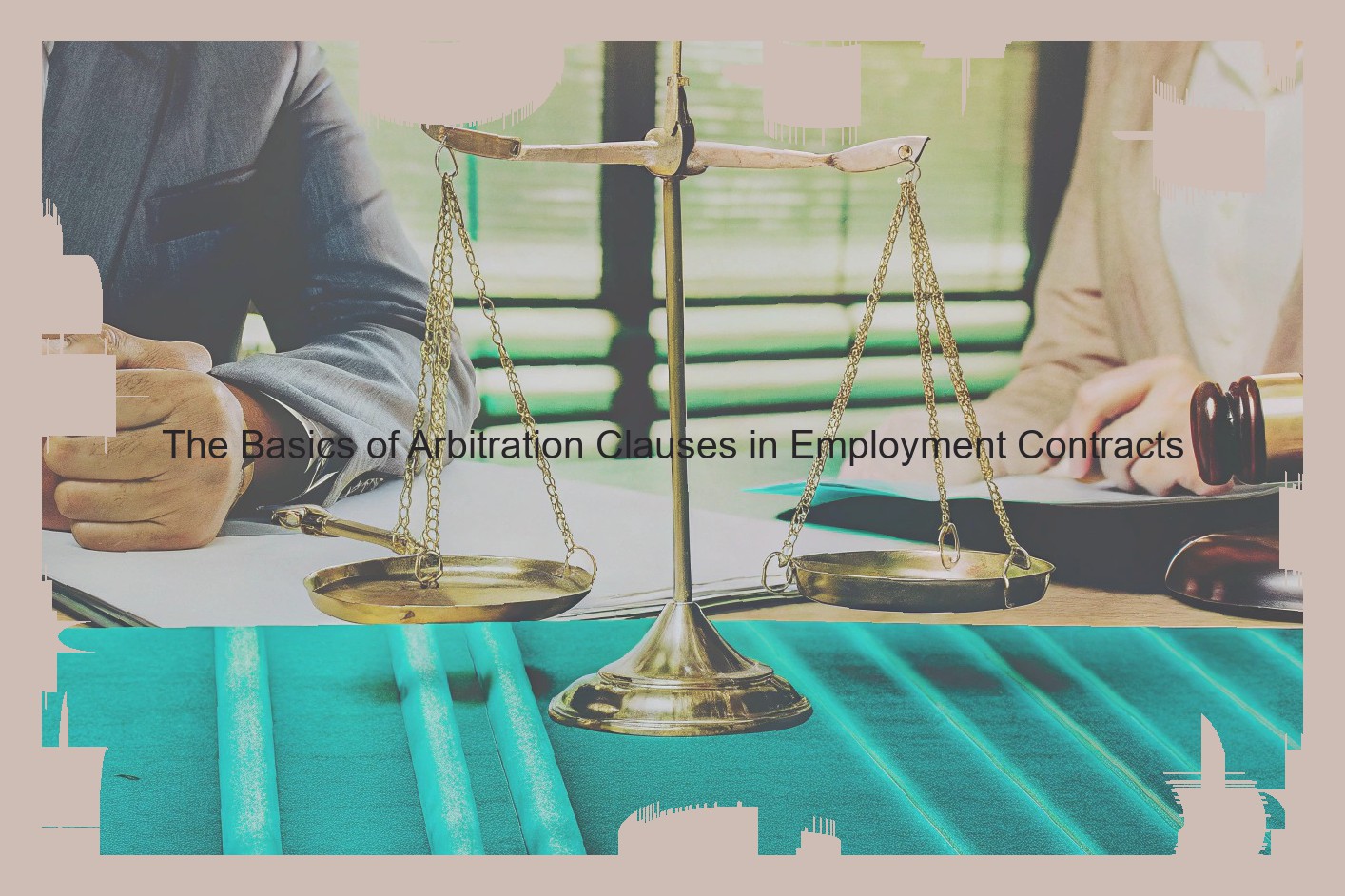What is an Arbitration Clause?
An arbitration clause is a provision often included in employment agreements and contracts that establishes how a dispute between the parties will be resolved. The basic premise behind arbitration is that the parties agree to take their legal dispute to an arbitrator, rather than the court system. An arbitrator is an independent, third party who evaluates a dispute between the parties and issues a decision. The purpose of an arbitration clause in an employment agreement is to streamline the process of legally resolving disputes so they are more efficient , more predictable, and more cost-effective for both the employer and employee. While arbitrators are not bound by technical rules of procedure, for the most part, arbitration is bidirectional; the employer may seek more in damages than it could in a court, while the employee may waive claims that they could have pursued in court.

Advantages of an Arbitration Clause
Grievances under the Employment Standards Act (ESA) are now resolved by the Ontario Ministry of Labour. This use of a public regulator may undermine some of the reasons employers include arbitration provisions in their collective agreement. However, it does not eliminate the advantages of arbitration clauses in employment agreements.
Cost-savings: Both parties save money because the grievance resolution process is faster than court. An example is the cost of legal fees. Arbitration hearing can be attended without a lawyer. Where the employment contract provides for payment of the costs of arbitrating an employment standards claim, the employee will usually seek a lawyer for assistance. The employer can expect to pay for counsel fees as well as the cost of the actual time spent by the lawyer in preparing and attending the hearing. This could add thousands of dollars to the cost of defending a claim. When the same issue is heard in court, the employer will incur major expenses in legal fees, court filing fees and other costs. (e.g. Disbursements in an Ontario Superior Court employment standards trial can exceed $20,000). In either process, the employer should expect the cost of having the matter resolved (within a reasonable timeframe) to be substantially less than if the matter was pursued in court.
Confidentiality: The hearing process is not public. Employment standards violation can be embarrassing for the employee and without telling anyone. The hearing is closed to the public. The parties who participated in the hearing will not be allowed to talk about the details of the claim to outside individuals. Because arbitration clause do not create a public record which can be accessed by the public, the parties are assured that the matter will not be heard by the public or revealed in a public record. In the instance where the employee wishes the hearing to be public, or in other words, the employee wants to be open about the claim, the employee can issue a court claim against the employer. However, this type of "publicity" usually means the employee will not be issued for a breach of the ESA and their dismissal may be found unlawful.
Time-savings: The hearing is expected to take no longer than 6 months after the date the company receives the notice of arbitration. This can be accomplished because the parties are able to advance the hearing date. They have the cooperation of the arbitrator who is paid by the parties and can adjust the schedule to accommodate a speedy resolution. The hearings are expedited because the arbitrator will only address 1 claim at time.
Not every hearing takes 6 months and the parties can ask the arbitrator to extend the date for hearing. However, in most cases the process is faster than proceeding in court.
Disadvantages of Arbitration
Nevertheless, critics of arbitration clauses in employment agreements contend that they are not always in employee’s best interest. For instance, the parties usually have limited rights of appeal with there is an unfavourable outcome at arbitration. Also, the nature of an arbitration hearing means that the proceedings are heard in a closed setting. This can limit an employee’s ability to seek recourse. Furthermore, sometimes something that seems like a clear issue of law may really be a question for the Court to decide.
Biased decisions by arbitrators are also a common criticism of employment arbitration. Employers, when drafting arbitration clauses, tend to select the arbitrator while employees are simply left to take whoever the employer chooses. It can be difficult for employees to challenge what they see as prefuted selections of arbitrators by their employer but, nevertheless, they are typically considered valid. Some advocates want to change that, with the aim of "ensuring that employees have a truly neutral decision-maker in the dispute". The idea is that any arbitrator selected must be seen as impartial and accepted by both parties. And yet, even if this were to happen, the same concerns that make some favour jury trials over judge trials, would still put limits on the degree to which an employee could feel confident in the decision of an arbitrator. Namely, jurors are more evenly presented with the facts of a case and are more likely to come to a consensus than a single arbitrator or panel of arbitrators. Furthermore, the appeal options available following a decision of an arbitrator, can make it difficult to correct errors made in the dispassionate adjudication of judgment. By way of example, an arbitrator may be more likely to find a technical wrong done to an employee than a judge. In such a case, if the employee feels hard done by, the appeal options may be limited to a judicial review of the decision, rather than a fresh hearing. The difference is that a judge may have applied different principles or standards than those used by the arbitrator. In such a case a judge could reach a different conclusion and award damages that the arbitrator had not, underlining the difference between the appeals in the two scenarios.
Some commentators express concern that the close nature of arbitration procedures leaves them unanswerable to public interest considerations. They compare this to the more open nature of court hearings (presuming that there will be a hearing and not a summary judgment motion) and how they impact, supposedly, society as a whole. In a courtroom, there is greater access to justice, or at least to the apparent justice of any result arrived at by a Court when compared to an arbitrator rendered decision. While there is some free availability of arbitral decisions, they are not the same as a judicial decision even with the boiling down of decisions into headnotes. Furthermore, with the costs associated with arbitration and the potential biases of arbitrators, there is less public interest in issues arising out of private arbitration as compared to a judicial hearing.
Applicable Law and Compliance
Arbitration clauses in employment contracts can be a valuable tool for employers, provided those clauses meet certain legal standards. The Federal Arbitration Act (FAA) governs the enforcement of arbitration agreements in the private sector, and requires that any agreement provide for a "written provision in any maritime transaction or a contract evidencing a transaction involving commerce to settle by arbitration a controversy thereafter arising out of such contract or transaction." 9 U.S.C. § 2. For agreement to exist, there must be a "manifestation of mutual assent to the terms thereof," Restatement (Second) of Contracts § 3 (1981). The FAA provides a federal forum for the enforcement of arbitration agreements, specifically preempting state laws that impede arbitration. The U.S. Supreme Court has noted that "we have held that agreements to arbitrate should be enforced like other contracts, but that those contracts are valid only if they satisfy the requirements of contract law generally applicable to contracts. In other words, a contract must be valid under applicable state law before it can be enforced under the FAA." First Options of Chicago, Inc. v. Kaplan, 514 U.S. 938, 944 (1995). Thus, state and federal contract law may both be consulted when determining the validity of an arbitration agreement.
With regard to termination of employment, state and federal statutory requirements significantly impact arbitration. Federal employment laws, including those enforced by the Equal Employment Opportunity Commission (EEOC), often require that covered entities provide some notice to employees of their rights under those statutes (i.e. ADA, ADEA, FMLA, Title VII and GINA). Congress has explicitly exempted EEOC Title VII claims from mandatory arbitration (42 U.S.C. § 2000e-2(n)) and this coverage extends to retaliation claims, as well as those brought under the Age Discrimination in Employment Act (ADEA), the Americans with Disabilities Act (ADA) and the Family Medical Leave Act (FMLA). The courts have also recognized that some protected categories may not be subject to mandatory arbitration. In Zapata v. Royal Caribbean Cruises, Ltd., 678 F. Supp. 2d 620 (S.D.N.Y. 2010), the court held that an employee’s New York City Human Rights Law (NYCHRL) claim was not subject to mandatory arbitration because the NYCHRL "seeks to provide more protection that federal or state law."
In addition to an employee’s right to file an EEOC charge for workplace discrimination, some employment agreements require that the employees waive their ability to bring a claim in any forum for certain employment-related claims, regardless of statutory requirements. Many of these cases involve termination of employment, but this is also an issue for applicants who do not get hired due to discrimination. Courts have routinely held that broad waiver language will be enforced, however they have also recognized that some rights cannot be waived, such as those accorded to EEOC. In Gilmer v. Interstate/Johnson Lane Corp., 500 U.S. 20 (1991), the Court held that a securities industry employee could be compelled to arbitrate his age discrimination claim despite his contention that he was precluded from bringing the claim before the EEOC.
Beyond federal law, many states have enacted laws that regulate the use of arbitration clauses with employees, contractors and agents. For example, California has a statute which provides that an employee, contractor or agent cannot be required to resolve alleged violations of any provision of the Labor Code through an arbitration as a condition of employment. California Labor Code § 229. The courts have interpreted this law to permit employers to require arbitration of claims arising under its internal policies and procedures, however not as a condition of employment. This issue is currently being contested in the California Supreme Court, in a case where an employer required all disputes be resolved in arbitration, which was held to be an unconscionable contract of adhesion.
While arbitration may be a valuable option for employers, challenging circumstances may arise in light of statutory requirements and the enforceability of arbitration clauses may be determined by the applicable state law.
Effective Arbitration Clause Drafting
Employers and employees must do their best to ensure their arbitration clauses are drafted in a clear and logical way. Hiring a lawyer with arbitration experience is a prudent step to ensure the wording is correct, and the process will be effective. Failure to use good wording can, at best, produce results similar to litigation and at worse, can create an ability for the clause to be voided.
While not exhaustive, the following list provides some best practices to craft a clear arbitration clause:
Name The Parties
Naming the parties is an important first step. While this seems basic, if for any reason there were ever any issues with the execution of the arbitration clause, or if no date is specified when signing the agreement, there can be difficulty determining who the employees are or for whom the employment agreement applies. To return to the previous example, if "You" were defined as "John Doe" the clause would only apply to that one person, not all employees. This becomes problematic if "XYZ, Inc." is the party defined as "You."
Keep It Short
All good things come in threes is a common saying, but it’s important to remember that less is often more. Keep the language of the clause as simple as possible. Large paragraphs full of caveats, exceptions, etc., are less likely to be enforced , which is counter to what arbitration clauses try to accomplish. Concise is the name of the game.
Choose Your Forum
Because arbitration is utilized in most jurisdictions, the place where the arbitration is to be held can make a big difference in the outcome of the dispute. If, for example, your business employs staff from across the country, it is better to name a federal district court or arbitrator with experience in the industry than a local arbitrator.
Be Specific in Scope
The scope of the agreement may be hard to enforce if it’s too broad. If the agreement states that it is to cover "all disputes" it will probably be challenged. Arbitrations are typically only appropriate for resolving contract disputes. Passing on employment claims such as wrongful termination may be prohibited.
Parties to an arbitration submit to the authority, rules, and jurisdiction of the process. At times, employees and employers may choose to send employment disputes to arbitration in lieu of litigation or mediation even if it may not in fact be required. This can save both time and money and increase the likelihood that an otherwise strong claim will go without judgment. Therefore, if an employer chooses to use arbitration, they should be sure they are using the proper language for the employees to be well informed and bound by its terms.
Arbitration Clause Enforcement and the Arbitration Process
Arbitration clauses are common and enforceable. The cornerstone for the enforcement of arbitration clauses exists in federal law: the Federal Arbitration Act of 1925. The Federal Arbitration Act mandates that all arbitration agreements be valid and enforceable. This includes provisions for arbitration agreements to be kept separate from other conditions of employment, such as consideration, ratification, or acceptance. It excludes from the definition of covered contracts employment agreements with workers engaged in interstate commerce. On a state level, whether or not an arbitration agreement is enforceable is determined by the general contract law of the state in which the agreement was made. Most state laws also recognized federal law regarding the enforcement of arbitration agreements, with courts who are hesitant to find an arbitration agreement unenforceable.
The enforcement of arbitration clauses is supported by several policy considerations. It is seen as an effective and cost-efficient form of dispute resolution. It requires retroactive and future claims to be resolved through a single hearing, avoiding conflicting decisions. Its focus on resolving the dispute through the submission of certain questions to the arbitrator offers a final decision in a relatively short period of time. Most importantly, it allows both sides of a dispute to resolve their differences in a confidential manner.
If an arbitration clause is enforced and a grievance proceeds to arbitration, the typical process is for the parties to agree upon an arbitrator. If they are unable to do so, an arbitrator will be chosen from a list by the American Arbitration Association. After the parties have selected an arbitrator, the normal process of service of the demand for arbitration is followed. Respondent has thirty days to respond to the claim. The claim enters discovery, followed by an initial hearing, prior to a hearing before the arbitrator.
The parties are encouraged to resolve their disputes without the need for formal hearings. However, oral or written statements may be allowed; the standard practice is a meeting between the parties and the arbitrator without the presence of a court reporter to discuss the issue. If submission of information is required, it is often soft-bounded in a booklet. An initial hearing with the arbitrator is then held that can last from one to three hours, though they can be up to two days. The purpose of this hearing is for the arbitrator to learn the issues that are to be resolved. They will decide if there needs to be a more formal arbitration session, or decide whether the dispute can be settled based on the arguments and materials presented.
Recent Updates and Patterns
In 2011, the U.S. Supreme Court decided AT&T Mobility LLC v. Concepcion, 563 U.S. 333 (2011), a case which has resulted in a tsunami of recent pro-employer decisions enforcing agreements requiring individual arbitration of employment claims, as well as prohibiting class and collective actions based on the Supreme Court’s view that an agreement to arbitrate is fundamentally a creature of contract. Concepcion involved three consolidated cases stemming from the Ninth Circuit. In AAA Northern California v. AT&T Mobility, (9th Cir. 2010) the Ninth Circuit refused to enforce a California state law rule similar to the one that the California Supreme Court invalidated in Discover Bank v. Super. Ct., 36 Cal.4th 148 (2005). The rule held that an arbitration clause is unconscionable and unenforceable if it requires consumers to bring claims individually even though they are similar to a large number of other consumers’ claims. The Court in AT&T Mobility found that enforcing arbitration agreements containing class waivers was unconscionable under the Discover Bank rule. And the same day the U.S. Supreme Court heard AT&T Mobility, it dismissed the writs in these two cases, without reaching the central issue, by vacating the Ninth Circuit’s decision and remanding to the trial courts for further appellate review. AT&T Mobility, LLC v. Ass’n of Am. Med. Colleges, Inc., 131 S. Ct. 2964 (2011); AT&T Mobility, LLC v. City Stores, LLC, 131 S. Ct. 2964 (2011). The Supreme Court granted the writ in AT&T Mobility, LLC v. Concepcion, 131 S. Ct . 1740 (2011) and reversed the Ninth Circuit’s decision that a clause in the parties’ arbitration agreement, which waived any class or representative procedure, was unenforceable "because it ‘disallows use of the class mechanism.’" Concepcion, 563 U.S. at 341. In AT&T Mobility, the Supreme Court rejected the Ninth Circuit’s holding and added to a growing list of decisions enforcing clauses requiring arbitration of employment claims on an individual basis. See also, American Express Co. v. Italian Colors Restaurant, __U.S. __, 133 S. Ct. 2304 (2013) (enforcing class action waiver clause in arbitration agreement in antitrust action); Oxford Health Plans LLC v. Sutter, 569 U.S. ____, 133 S. Ct. 2064 (2013) (enforcing class action waiver clause in arbitrator’s determination that he lacked authority to compel enforcement of class procedures); Stolt-Nielsen S.A. v. AnimalFeeds Int’l Corp., 559 U.S. 662 (2010) (party cannot be compelled to submit to class arbitration further ensuring that employment disputes cannot be heard on a class basis). Other courts have followed suit and invalidated a range of statutes that restricted the availability of individual arbitrations. See, e.g., Sanchez v. Carmax Auto Superstores, Inc., 224 Cal. App.4th 398 (2014) (California Private Attorneys General Act claims); Blair v. Rent-A-Center, Inc., 928 F.Supp.2d 1131 (C.D. Cal. 2013)(California Labor Code Private Attorneys General Act of 2004 claims); Cohen v. DirecTV, Inc., 178 Cal.App.4th 1294 (2009) (applying Discover Bank rule to the Federal Arbitration Act). As a result, the Concepcion and its progeny have resulted in an increase in courts enforcing agreements requiring individual arbitration of employment disputes.



